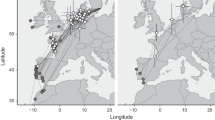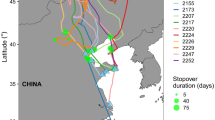Abstract
Many studies suggest that migratory birds are expected to travel more quickly during spring, when they are en route to the breeding grounds, in order to ensure a high-quality territory. Using data recorded by means of Global Positioning System satellite tags, we analysed at three temporal scales (hourly, daily and overall journey) seasonal differences in migratory performance of the booted eagle (Aquila pennata), a soaring raptor migrating between Europe and tropical Africa, taking into account environmental conditions such as wind, thermal uplift and day length. Unexpectedly, booted eagles showed higher travel rates (hourly speed, daily distance, overall migration speed and overall straightness) during autumn, even controlling for abiotic factors, probably thanks to higher hourly speeds, more straight routes and less non-travelling days during autumn. Tailwinds were the main environmental factor affecting daily distance. During spring, booted eagles migrated more quickly when flying over the Sahara desert. Our results raise new questions about which ecological and behavioural reasons promote such unexpected faster speeds in autumn and not during spring and how events occurring in very different regions can affect migratory performance, interacting with landscape characteristics, weather conditions and flight behaviour.


Similar content being viewed by others
References
Agostini N, Mellone U (2007) Migration strategies of oriental honey-buzzards Pernis ptilorhyncus breeding in Japan. Folktail 23:182–183
Alerstam T (2003) Bird migration speed. In: Berthold P, Gwinner E, Sonnenschein E (eds) Avian migration. Springer, Berlin, pp 253–267
Alerstam T (2006) Strategies for the transition to breeding in time-selected bird migration. Ardea 94:347–357
Alerstam T (2011) Optimal bird migration revisited. J Ornithol 152:S5–S23
Alerstam T, Hedenström A (1998) The development of bird migration theory. J Avian Biol 29:343–369
Alerstam T, Lindstrom A (1990) Optimal bird migration: the relative importance of time, energy and safety. In: Gwinner E (ed) Bird migration: physiology and ecophysiology. Springer, Berlin, pp 331–351
Baghino L, Premuda G, Gustin M, Corso A, Mellone U, Cardelli C (2007) Exceptional wintering and spring migration of the booted eagle Hieraaetus pennatus in Italy in 2004 and 2005. Avocetta 31:47–52
Benhamou S (2004) How to reliably estimate the tortuosity of an animal’s path: straightness, sinuosity or fractal dimension? J Theor Biol 229:209–220
Bildstein KL (2006) Migrating raptors of the world. Cornell University Press
Borher G, Brandes D, Mandel J, Bildstein K, Miller T, Lanzone M, Katzner T, Maisonneuve C, Tremblay JA (2012) Estimating updraft velocity components over large spatial scales: contrasting migration strategies of golden eagles and turkey vultures. Ecol Lett 15:96–103
Chevallier D, Handrich Y, Georges JY, Baillon F, Brossault P, Aurouet A, Le Maho Y, Massemin S (2010) Influence of weather conditions on the flight of migrating black storks. Proc R Soc Lond B 277:2755–2764
Cramp S, Simmons KEL (1980) The birds of western Palaearctic. Oxford University Press, Oxford
García-Ripollés C, López-López P, Urios V (2010) First description of migration and wintering of adult Egyptian vultures Neophron percnopterus tracked by GPS satellite telemetry. Bird Study 57:261–265
Greenberg R (1986) Competition in migrant birds in the nonbreeding season. In: Johnston RF (ed) Current ornithology 3. Plenum Press, New York, pp 281–307
Hake M, Kjellen N, Alerstam T (2003) Age-dependent migration strategy in honey buzzards Pernis apivorus tracked by satellite. Oikos 103:385–396
Higuchi H, Shiu HJ, Nakamura H, Uematsu A, Kuno K, Saeki M, Hotta M, Tokita KI, Moriya E, Morishima E, Tamura M (2005) Migration of honey-buzzards Pernis apivorus based on satellite tracking. Ornithol Sci 4:109–115
Kemp MU, van Loon EE, Shamoun-Baranes J, Bouten W (2012) RNCEP: global weather and climate data at your fingertips. Methods Ecol Evol 3:65–70
Kerlinger P (1989) Flight strategies of migrating hawks. University of Chicago Press, Chicago
Klaassen RHG, Strandberg R, Hake M, Alerstam T (2008) Flexibility in daily travel routines causes regional variation in bird migration speed. Behav Ecol Sociobiol 62:1427–1432
Klaassen RHG, Hake M, Strandberg R, Alerstam T (2011) Geographical and temporal flexibility in the response to crosswinds by migrating raptors. Proc R Soc Lond B 278:1339–1346
Klaassen RHG, Hake M, Strandberg R, Koks BJ, Trierweiler C, Exo KM, Bairlein F, Alerstam T (2014) When and where does mortality occur in migratory birds? Direct evidence from long-term satellite tracking of raptors. J Anim Ecol 83:176–184
Kokko H (1999) Competition for early arrival in migratory birds. J Anim Ecol 68:940–950
Leisler B (1990) Selection and use of habitat of wintering migrants. In: Gwinner E (ed) Bird migration: the physiology and ecophysiology. Springer, Berlin, pp 156–173
Liechti F (2006) Birds: blowin’ by the wind? J Ornithol 147:202–211
López-López P, Limiñana R, Mellone U, Urios V (2010) From the Mediterranean sea to Madagascar. Are there ecological barriers for the long-distance migrant Eleonora’s falcon? Land Ecol 25:803–813
López-López P, Benavent-Corai J, García-Ripollés C, Urios V (2013) Scavengers on the move: behavioural changes in foraging search patterns during the annual cycle. PLoS ONE 8:e54352
López-López P, García-Ripollés C, Urios V (2014a) Food predictability determines space use of endangered vultures: implications for management of supplementary feeding. Ecol Appl 24:939–949
López-López P, García-Ripollés C, Urios V (2014b) Individual repeatability in timing and spatial flexibility of migration routes of trans-Saharan migratory raptors. Curr Zool 60:642–652
Mandel JT, Bohrer G, Winkler DW, Barber DR, Houston CS, Bildstein K (2011) Migration path annotation: cross-continental study of migration-flight response to environmental conditions. Ecol Appl 21:2258–2268
Martínez JE, Sánchez-Zapata JA (1999) Invernada de aguililla calzada (Hieraaetus pennatus) y culebrera europea (Circaetus gallicus) en España. Ardeola 46:93–96
McNamara JM, Welham RK, Houston AI (1998) The timing of migration within the context of an annual routine. J Avian Biol 29:416–423
Mellone U, López-López P, Limiñana R, Urios V (2011) Weather conditions promote route flexibility during open ocean crossing in a long-distance migratory raptor. Int J Biomet 55:463–468
Mellone U, Klaassen RHG, García-Ripollés C, Limiñana R, López-López P, Pavon D, Strandberg R, Urios V, Vardakis M, Alerstam T (2012) Interspecific comparison of the performance of soaring migrants in relation to morphology, meteorological conditions and migration strategies. PLoS ONE 7:e39833
Mellone U, De La Puente J, López-López P, Limiñana R, Bermejo A, Urios V (2013a) Migration routes and wintering areas of booted eagles Aquila pennata breeding in Spain. Bird Study 60:409–413
Mellone U, López-López P, Limiñana R, Piasevoli G, Urios V (2013b) The trans-equatorial loop migration system of Eleonora’s falcon: differences in migration patterns between age classes, regions and seasons. J Avian Biol 44:417–426
Newton I (2008) The migration ecology of birds. Academic Press, London
Nilsson C, Klaassen RH, Alerstam T (2013) Differences in speed and duration of bird migration between spring and autumn. Am Nat 181:837–845
Panuccio M, Agostini N, Wilson S, Lucia G, Ashton-Booth J, Chiatante G, Mellone U, Todisco S (2006) Does the honey-buzzard feed during migration? Brit Birds 99:367–368
Panuccio M, Agostini N, Mellone U, Bogliani G (2014) Circannual variation in movement patterns of the black kite (Milvus migrans migrans): a review. Ethol Ecol Evol 26:1–18
Sillett TS, Holmes RT (2002) Variation in survivorship of a migratory songbird throughout its annual cycle. J Anim Ecol 71:296–308
Sirot E, Touzalin F (2014) Temporal patterns of arrival from migration as a response to competition for breeding space. J Avian Biol 45:109–112
Smith NG, Goldstein DL, Bartholomew GA (1986) Is long-distance migration possible for soaring hawks using only stored fat? Auk 103:607–611
Spaar R (1997) Flight strategies of migrating raptors: a comparative study of interspecific variation in flight characteristics. Ibis 139:523–535
Strandberg R, Klaassen RHG, Olofsson P, Alerstam T (2009) Daily travel schedules of adult eurasian hobbies Falco subbuteo—variability in flight hours and migration speed along the route. Ardea 97:287–295
Strandberg R, Klaassen RHG, Hake M, Alerstam T (2010) How hazardous is the Sahara desert crossing for migratory birds? Indications from satellite tracking of raptors. Biol Lett 6:297–300
Thorup K, Alerstam T, Hake M, Kjellen N (2003) Bird orientation: compensation for wind drift in migrating raptors is age dependent. Proc R Soc Lond B 270:S8–S11
Thorup K, Alerstam T, Hake M, Kjellen N (2006) Traveling or stopping of migrating birds in relation to wind: an illustration for the osprey. Behav Ecol 17:497–502
Trierweiler C, Mullié WC, Drent RH, Exo KM, Komdeur J, Bairlein F, Harouna A, de Bakker M, Koks BJ (2013) A Palaearctic migratory raptor species tracks shifting prey availability within its wintering range in the Sahel. J Anim Ecol 82:107–120
Yamaguchi N, Tokita KI, Uematsu A, Kuno K, Saeki M et al (2008) The large-scale detoured migration route and the shifting pattern of migration in oriental honey-buzzards breeding in Japan. J Zool (Lond) 276:54–62
Zuur AF, Ieno EN, Walker NJ, Saveliev AA, Smith, G (2009) Mixed Effects Models and Extensions in Ecology with R. Springer, New York
Acknowledgements
All information about tagged Eagles has been obtained in the framework of the ‘Migra’ project (www.migraciondeaves.org/en/) developed by SEO/BirdLife and financed by Iberdrola Foundation. The Extremadura Regional Government provides information on two tagged booted eagles (special thanks to D. Rivera). Grefa and Generalitat Valenciana provided fieldwork material. Thomas Alerstam and an anonymous reviewer made useful comments on a first version of the manuscript. We are very grateful to Ana Mellado for the statistical pieces of advice. Different people from La Rioja Government Conservation and Biodiversity from Dirección General de Medio Natural, forest agents from Málaga and Madrid, SEO-Málaga Ornithological Group, Montes de Málaga Natural Park, FAB, GIA-León, research group in Mediterranean Ecosystems from Murcia University Murcia helped during fieldwork and location of pairs: A. Llopis, A. Leal, B. Fuertes, C. Pino, C. Ponce, D. Miguélez, E. Herrero, E. Miera, E. Navarro, F. Bustamante, F. de la Cruz, F. Ortega, G. Sierra, G. Negrete, H. Astiárraga, I. Gámez I. García, J. Bosch J.A. Cortés, J.E. Martínez, J.F. Calvo, J.F. Pedreño, J.C. del Moral, J. Robres, J.J. Jiménez, J.M. Abad, L.A. Ramos, M. Aguilera, M. Moreno, M.V. Jiménez, N. Rodríguez, P. Díaz, R.A. Haro, R. Ruiz, R. Prades and T. Álvarez. PL-L is supported by a ‘Juan de la Cierva’ postdoctoral grant of the Spanish Ministry of Science and Innovation (reference JCI-2011-09588).
Ethical standards
This work complies with the current environmental laws in Spain, and all necessary permissions to catch and deploy transmitters were provided by the environmental departments of the regional governments of Andalucía, Castilla y León, Cataluña, Comunidad Valenciana, Extremadura, La Rioja, Madrid and Murcia.
Conflict of interest
Authors declare that no conflict of interest exists.
Author information
Authors and Affiliations
Corresponding author
Additional information
Communicated by W. Wiltschko
Rights and permissions
About this article
Cite this article
Mellone, U., De La Puente, J., López-López, P. et al. Seasonal differences in migration patterns of a soaring bird in relation to environmental conditions: a multi-scale approach. Behav Ecol Sociobiol 69, 75–82 (2015). https://doi.org/10.1007/s00265-014-1818-4
Received:
Revised:
Accepted:
Published:
Issue Date:
DOI: https://doi.org/10.1007/s00265-014-1818-4




